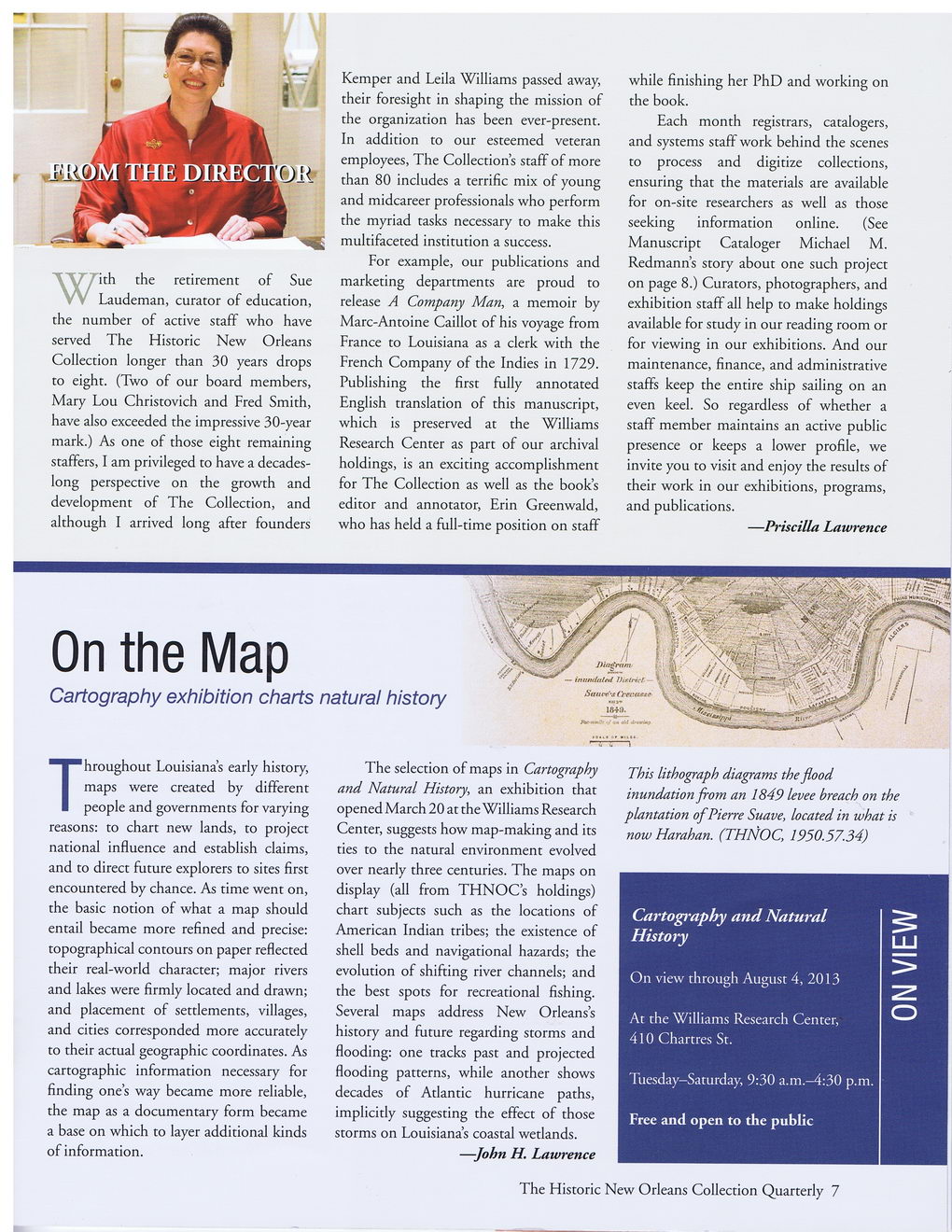This text was obtained via automated optical character recognition.
It has not been edited and may therefore contain several errors.
TWith retirement of Sue W Laudeman, curator of education, the number of active staff who have served The Historic New Orleans Collection longer than 30 years drops to eight. (Two of our board members, Mary Lou Christovich and Fred Smith, have also exceeded the impressive 30-year mark.) As one of those eight remaining staffers, I am privileged to have a decades-long perspective on the growth and development of The Collection, and although I arrived long after founders Kemper and Leila Williams passed away, their foresight in shaping the mission of the organization has been ever-present. In addition to our esteemed veteran employees, The Collections staff of more than 80 includes a terrific mix of young and midcareer professionals who perform the myriad tasks necessary to make this multifaceted institution a success. For example, our publications and marketing departments are proud to release A Company Man, a memoir by Marc-Antoine Caillot of his voyage from France to Louisiana as a clerk with the French Company of the Indies in 1729. Publishing the first fully annotated English translation of this manuscript, which is preserved at the Williams Research Center as part of our archival holdings, is an exciting accomplishment for The Collection as well as the book’s editor and annotator, Erin Greenwald, who has held a full-time position on staff while finishing her PhD and working on the book. Each month registrars, catalogers, and systems staff work behind the scenes to process and digitize collections, ensuring that the materials are available for on-site researchers as well as those seeking information online. (See Manuscript Cataloger Michael M. Redmann’s story about one such project on page 8.) Curators, photographers, and exhibition staff all help to make holdings available for study in our reading room or for viewing in our exhibitions. And our maintenance, finance, and administrative staffs keep the entire ship sailing on an even keel. So regardless of whether a staff member maintains an active public presence or keeps a lower profile, we invite you to visit and enjoy the results of their work in our exhibitions, programs, and publications. —Priscilla Lawrence On the Map Cartography exhibition charts natural history Throughout Louisiana’s early history, maps were created by different people and governments for varying reasons: to chart new lands, to project national influence and establish claims, and to direct future explorers to sites first encountered by chance. As time went on, the basic notion of what a map should entail became more refined and precise: topographical contours on paper reflected their real-world character; major rivers and lakes were firmly located and drawn; and placement of settlements, villages, and cities corresponded more accurately to their actual geographic coordinates. As cartographic information necessary for finding one’s way became more reliable, the map as a documentary form became a base on which to layer additional kinds of information. The selection of maps in Cartography and Natural History, an exhibition that opened March 20 at the Williams Research Center, suggests how map-making and its ties to the natural environment evolved over nearly three centuries. The maps on display (all from THNOC’s holdings) chart subjects such as the locations of American Indian tribes; the existence of shell beds and navigational hazards; the evolution of shifting river channels; and the best spots for recreational fishing. Several maps address New Orleans’s history and future regarding storms and flooding: one tracks past and projected flooding patterns, while another shows decades of Atlantic hurricane paths, implicitly suggesting the effect of those storms on Louisiana’s coastal wetlands. —John H. Lawrence This lithograph diagrams the flood inundation from an 1849 levee breach on the plantation of Pierre Suave, located in what is now Harahan. (THNOC, 1950.57.34) Cartography and Natural History LU On view through August 4, 2013 > At the Williams Research Center, o 410 Chartres St. Tuesday-Saturday, 9:30 a.m.-4:30 p.m. Free and open to the public The Historic New Orleans Collection Quarterly 7

New Orleans Quarterly 2013 Spring (07)